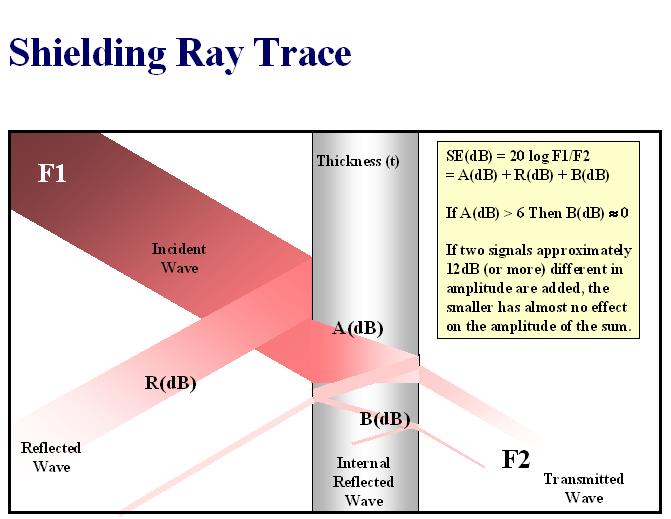AGENDA – GROUNDING/BONDING/SHIELDING
 Shielding is the proven approach for systems that are impossible to cost effectively EMC harden. Shielding can be used at the PC board level to protect sensitive circuits as well as at the systems level. Larger systems can be placed in shielded rooms or even shielded facilities. Regardless of the size, shielding works the same way. However the grounding, bonding, and cabling approach for larger enclosures will be much different than that used at the PCB level.
Shielding is the proven approach for systems that are impossible to cost effectively EMC harden. Shielding can be used at the PC board level to protect sensitive circuits as well as at the systems level. Larger systems can be placed in shielded rooms or even shielded facilities. Regardless of the size, shielding works the same way. However the grounding, bonding, and cabling approach for larger enclosures will be much different than that used at the PCB level.
Shielding also effectively reduces internal crosstalk and circuit-path coupling as well. In many cases, shielding can eliminate the need for filters. Even if filters are required, a shield provides a superior RF sink and filter input/output isolation. Shielding works . . . plus it doesn’t affect signal integrity! An important factor with today’s ultra high-speed systems! It’s the only suppression component that is not a circuit element, which accounts for shielding being one of the most widely used ways of meeting EMC requirements.
EMC BASICS, CULPRITS, AND VICTIMS
Background Information
Terms, Units, Decibels
Time to Frequency Conversion
Overview of Typical EMI Levels/Coupling
Power Line Disturbances
Transients - ESD, Lightning, EMP
FAST Analysis
GROUNDING/BONDING FOR EMC
Grounding
Safety Earthing/Grounding vs EME Coupling
Grounding Myths vs Reality
Electrical Shock Avoidance (UL, NEC Req's)
Lightning Protection Systems
Lightning Rods and Earthing
Filter Grounding
Bonding and Common Impedance Coupling
Bond Zo of Round/Flat Conductors & Planes
Contact Surfaces
Galvanic Corrosion
Practical Solutions, from PCB to Room Level
Common Zo Coupling Reduction on PCB's
Impedance Reduction
Multilayer Boards
Cable Differential/Common Mode Coupling
Field to Wire-Pair and Wire-Pair to Field
Twisting
Shielding
Field to Grnd Loop Coupling & Reduction
Common Mode to Diff Mode Conversion
Floating & Single Point Grounding
Balanced Line Drivers/Receivers
Series RF Inductors
Double Shielding
Shielded Transformers and Baluns
Ferrites
Optical Coupling
SHIELDING FOR EMC
Shielding Effectiveness (SE) of Barriers
Near Field (EF and HF)
Far Field/Plane Wave
Metal Barrier Performance
External/Internal Reflection & Absorption
Cavity Amplification
Shielding Performance of Typical Metals
Low Frequency Magnetic Shielding
Conductive Coatings/Metallized Plastics
Cable Shields - Balanced Pairs and Coax
Cable Shields - Ideal vs Comp. Practices
Coaxial Cable Shielding
Shielding Effectiveness vs Zt
Field Coupling to Coaxial Cables
Grounding Rules for Cable Shields
Flat Ribbon Cables
Connectors and Pigtails
Enclosure Shielding - Aperture Leakage
General Model for Enclosure SE
Calculation of Aperture SE
Combination of Multiple Apertures
SE of Screen Meshes
Conductive Glass
Waveguide-Below-Cutoff Effect
Honeycomb Air Filters
Component Penetrations (Fuses, Switches, Meters, Displays, etc.)
EMI Gaskets/Corrosion Control
www.ronbrewer.com
 Shielding is the proven approach for systems that are impossible to cost effectively EMC harden. Shielding can be used at the PC board level to protect sensitive circuits as well as at the systems level. Larger systems can be placed in shielded rooms or even shielded facilities. Regardless of the size, shielding works the same way. However the grounding, bonding, and cabling approach for larger enclosures will be much different than that used at the PCB level.
Shielding is the proven approach for systems that are impossible to cost effectively EMC harden. Shielding can be used at the PC board level to protect sensitive circuits as well as at the systems level. Larger systems can be placed in shielded rooms or even shielded facilities. Regardless of the size, shielding works the same way. However the grounding, bonding, and cabling approach for larger enclosures will be much different than that used at the PCB level.